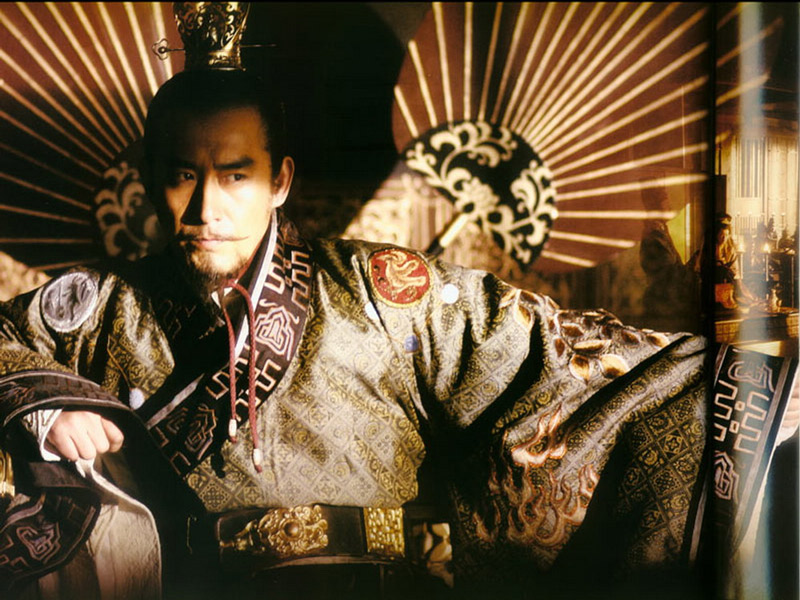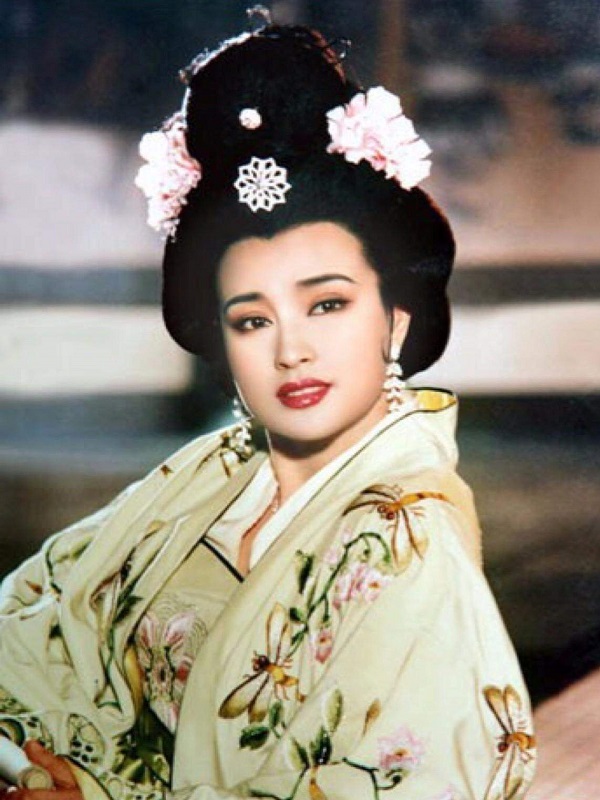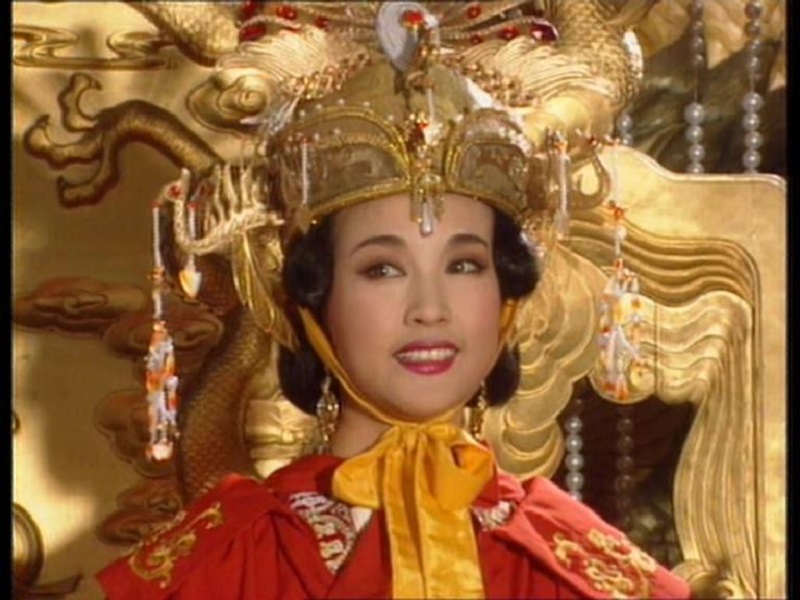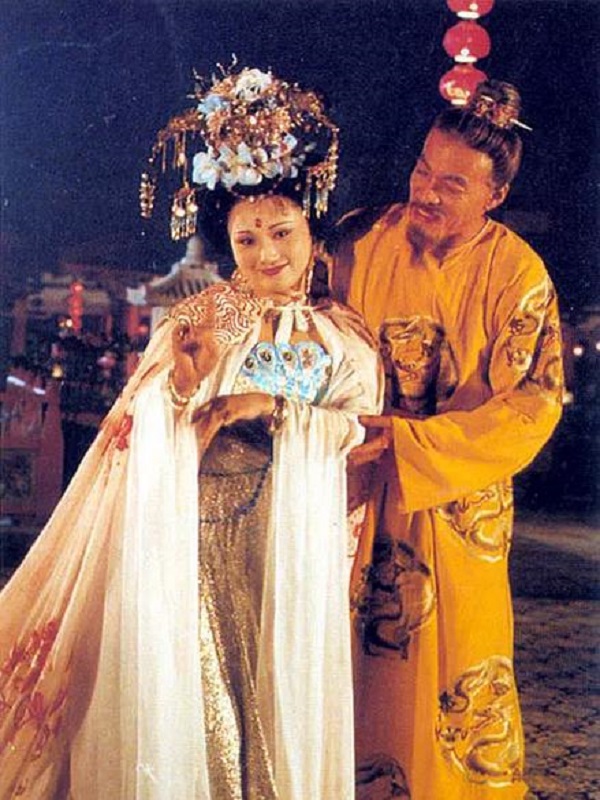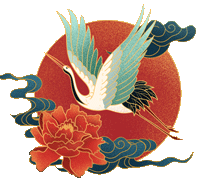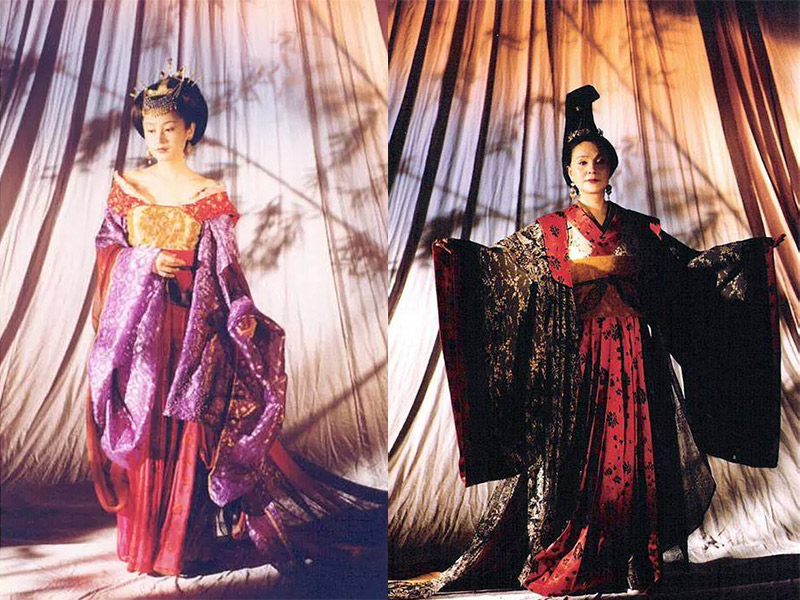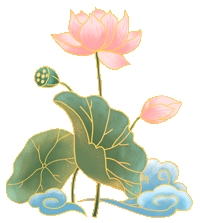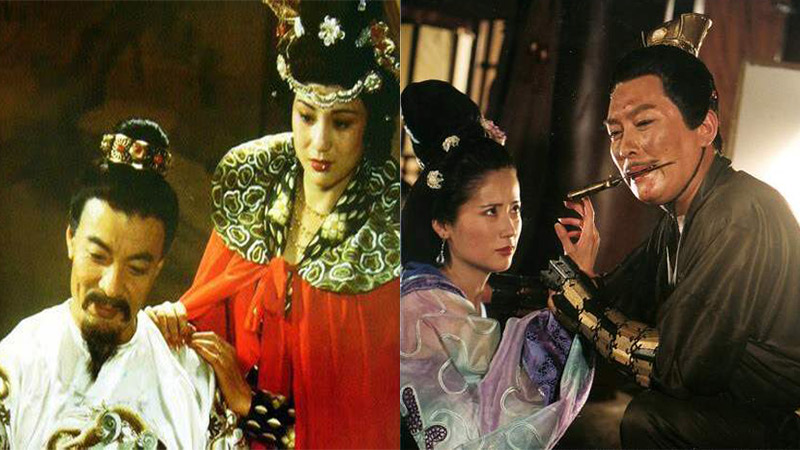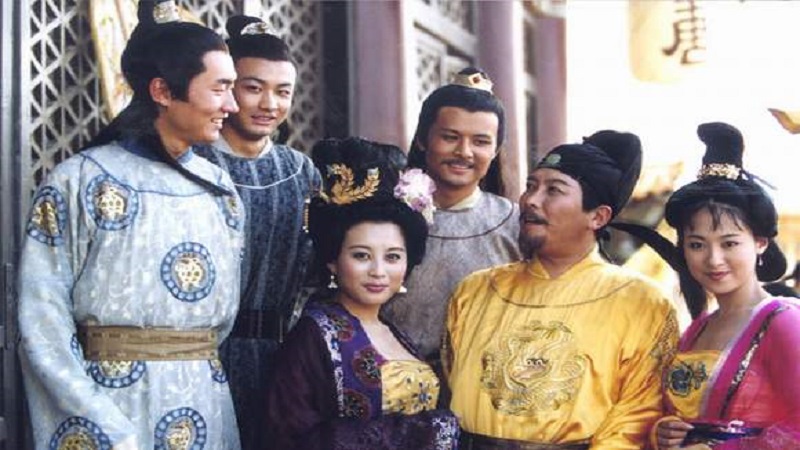
In 618 CE, as Sui Dynasty excesses sparked rebellion, a daring aristocrat named Li Yuan seized Chang'an, founding the Tang Dynasty (618–907 CE). Under his son, Emperor Taizong, Tang became a golden age—a cosmopolitan empire where Persian merchants, Korean scholars, and Uyghur horsemen mingled in silk-clad streets. Poetry flourished with Li Bai's verses, diplomacy stretched to Baghdad, and Buddhist pagodas pierced the skies. Yet Tang's splendor was tempered by treachery: palace coups, concubines' schemes, and the cataclysmic An Lushan Rebellion that left a million dead.
The Tang's two centuries of zenith saw unmatched innovation: woodblock printing spread knowledge, imperial exams elevated commoners, and women like Empress Wu Zetian shattered ceilings, ruling as China's sole female emperor. But this was also an era of extremes. Emperor Xuanzong's passion for concubine Yang Guifei birthed both art and ruin, while the Silk Road brought riches—and bloodshed—as Tibetan and Turkic armies challenged Tang's borders.
Hungry for opulence and intrigue? Step into the splendor of Chang'an's lantern-lit nights, where poets duel with brushstrokes and spies whisper in tea houses. Marvel at Wu Zetian's ruthless ascent from concubine to empress, or let your heart break with the tragic romance of Xuanzong and Yang Guifei—a love that ignited an empire's downfall. Feel the ground shake as An Lushan's cavalry descends, testing loyalties in a storm of fire and betrayal. Don't just watch history—live it. Uncover the secrets of a dynasty where dancers became rulers, monks swayed emperors with Zen riddles, and every smile hid a dagger. The Tang's glory is calling—will you answer? Pack your curiosity and dive into an age where legends aren't just born… they're conquered.
 The Zenith of Zhenguan (2006) 贞观之治
The Zenith of Zhenguan (2006) 贞观之治
For a drama that bridges rigorous scholarship and gripping narrative, The Zenith of Zhenguan stands apart. Rather than romanticizing the Tang Dynasty's golden age, it anchors its storytelling in the socio-political bedrock that made the "Zhenguan Reign" (627–649) a paradigm of governance. Here's why it remains unmatched in contextualizing history:
Grounding in Post-War Turmoil
The series opens not with grandeur but with the ashes of the Sui Dynasty (隋朝), a period marked by Emperor Yang's disastrous campaigns and systemic collapse. Through stark visuals—abandoned farmlands, starving refugees, and crumbling infrastructure—it establishes why Li Yuan ( founder of Tang Dynasty) and later Li Shimin had to rebuild from near ruin.
Policy-Driven Narrative
Unlike dramas that reduce governance to palace intrigue, Zhenguan dedicates screen time to institutional reforms:
Meritocracy Over Nepotism: Scenes of Li Shimin debating with aristocratic factions highlight his push to recruit talent via imperial exams (科举制), a system he expanded to weaken noble monopolies.
Tax Reforms: A subplot follows the implementation of the Equal Field System (均田制), which redistributed land to peasants, directly tying economic recovery to social stability.
Legal Codification: The series dramatizes the creation of the Zhenguan Legal Code (贞观律), emphasizing its balance between Confucian ethics and legal rigor.
These threads are woven into character arcs. For example, Chancellor Wei Zheng's famed bluntness isn't just a personality quirk—it reflects the emperor's deliberate cultivation of dissent to avoid Sui-style autocracy.

Humanizing Historical Figures
The drama avoids hagiography. Li Shimin is depicted as a flawed visionary:
Guilt and Ambition: His nightmares about the Xuanwu Gate killings (killing his brothers) humanize him, while his speeches about "learning from the Sui's fall" reveal a ruler haunted by history.
Cultural Nuance: The series highlights his patronage of Buddhism and Daoism not as piety but as tools for social cohesion, contrasting with his father's reliance on Confucian orthodoxy.
Supporting characters like Empress Zhangsun and general Li Jing are similarly layered. The empress's role extends beyond the harem—she's shown advising on military logistics and mediating factional disputes.
Visualizing Historical Authenticity
The production's commitment to accuracy elevates its narrative credibility:
Architectural Precision: Reconstructed Tang-era palaces and the 108-block layout of Chang'an (长安) were based on archaeological findings, offering viewers a tactile sense of the era's urban planning.
Costume Codes: Officials' robes adhere to the Tang Huiyao (唐会要, collection of court decrees) regulations, with rank-specific colors and insignia—a detail often glossed over in other period dramas.
Documentary Interludes: Scroll-style animations explain policies like the Fubing System (府兵制), blending exposition with aesthetic flair.
By contextualizing Zhenguan's triumphs within post-crisis rebuilding, the series offers timeless lessons:
Leadership as Pragmatism: Li Shimin's willingness to adapt Sui infrastructure (e.g., the Grand Canal) while discarding its tyranny mirrors modern debates about reforming legacy systems.
Transparency vs. Stability: The drama's emphasis on open governance (e.g., court debates archived for public scrutiny) parallels contemporary discussions on bureaucratic accountability.
The Zenith of Zhenguan transcends typical historical drama by making policy as compelling as plot. Its genius lies in showing how grand strategies—land reform, legal codification, diplomatic marriages—were born from acute awareness of past failures. For viewers seeking not just what happened but why it mattered, this series is an indispensable lens into China's most studied golden age.
 Empress Wu Zetian (1995) 武则天
Empress Wu Zetian (1995) 武则天
Few historical figures polarize like Wu Zetian (武则天), China's only female emperor. The 1995 series Empress Wu Zetian neither vilifies nor sanctifies her—it dissects her rise through the gendered politics of Tang China, revealing how she weaponized Confucian contradictions to seize power. Here's why it remains a benchmark for nuanced historical storytelling:
Framing Her Ascent in Tang's Patriarchal Machinery
The series opens with 14-year-old Wu entering Emperor Taizong's harem as a cairen (才人, fifth-rank concubine). Rather than romanticizing her youth, it underscores the structural misogyny she navigated:
Harem Hierarchy: Close-ups of ritualized humiliation—like concubines kneeling for hours during ceremonies—visually reinforce the system's dehumanizing rigor.
Widowhood Stigma: After Taizong's death, Wu is consigned to Ganye Temple, a "living tomb" for childless concubines. Her shaved head and monastic robes symbolize erasure from history.
Key scenes:
Taizong's Deathbed: Wu's whispered plea—"Your Majesty, I don't want to die"—captures Tang's brutal custom of burying concubines alive with emperors.
Return to Court: Her reunion with Emperor Gaozong (Taizong's son) isn't framed as romance but as calculated survival; she leverages Gaozong's insecurity against his domineering wife, Empress Wang.
Power as Performance
The series excels in showing how Wu manipulated Confucian performativity to legitimize her rule:
Motherhood as Shield: After bearing Gaozong's sons, she petitions to establish a maternal shrine for her peasant father—a shrewd move to elevate her clan's status while appearing filial.
Buddhist Symbolism: Her commissioning of the Commentaries on the Great Cloud Sutra (大云经) reimagines her as Maitreya Buddha incarnate, exploiting religion to reframe her usurpation as divine mandate.
Yet the drama avoids reducing her to a schemer. In one pivotal scene, Wu executes her infant daughter to frame Empress Wang—a moment rendered not as villainy but as existential desperation. The camera lingers on her trembling hands afterward, humanizing her moral compromises.
Institutional Innovation, Not Just Intrigue
While palace plots drive the narrative, the series dedicates equal weight to Wu's policy revolutions:
Meritocratic Examinations: She expanded the imperial exams to recruit commoners and ethnic minorities, destabilizing the aristocratic Shandong Clans (山东士族) who opposed her.
Espionage Networks: Her "Copper Box" (铜匦) system—a mailbox for public grievances and secret accusations—prefigured modern whistleblower mechanisms, albeit weaponized against rivals.
Military Pragmatism: By promoting non-Han generals like Xue Rengui, she secured border stability while reducing Han warlords' influence.
These threads are humanized through conflicts. For example, her rivalry with chancellor Pei Yan isn't personal but ideological: he represents the old guard clinging to Confucian gender norms, while she champions bureaucratic pragmatism.
Visualizing Tang's Cultural Paradoxes
The production's attention to detail grounds Wu's story in Tang's material culture:
Costume Semiotics: Early episodes dress Wu in pastel silks as a concubine; as empress, she adopts dragon-embroidered crimson robes—a deliberate violation of sumptuary laws that signals her defiance.
Architectural Symbolism: The series contrasts the Forbidden City's rigid symmetry with Wu's lush, asymmetrical private gardens—a visual metaphor for her disruption of male-dominated spaces.

Confronting Historical Ambiguities
The series leans into controversies modern historians still debate:
Patricide Allegations: While traditional accounts accuse Wu of poisoning Gaozong, the drama presents conflicting evidence—a delirious Gaozong clutching an empty medicine bowl, but no explicit confession.
Legacy of Violence: Her reign's death toll (including sons and grandsons) is contextualized within Tang's broader cycle of kin-slaying, from Taizong's Xuanwu Gate massacre to later emperors' purges.
Empress Wu Zetian resonates because it reframes her not as an anomaly but as a product and critic of systemic inequities. Modern parallels abound:
Gender Double Standards: Wu's critics labeled her "ruthless" for tactics male emperors used without censure—a tension echoing contemporary discussions about female leaders' perceived "likability."
Merit vs. Birth: Her exam reforms mirror today's debates about affirmative action and elite university admissions.
This series transcends the "feminist icon" trope to explore how power corrupts and liberates in equal measure. Liu Xiaoqing's performance—equal parts vulnerability and ruthlessness—anchors the drama, but it's the writing's refusal to simplify that makes Empress Wu Zetian endure. By framing her reign within Tang's institutional decay and cultural vibrancy, it offers a provocative thesis: Wu didn't break the system—she exposed its fractures.
 The Glory and Decadence of Tang (1993) 唐明皇
The Glory and Decadence of Tang (1993) 唐明皇
Aired in 1993, The Glory and Decadence of Tang unravels the tragic arc of Emperor Xuanzong's reign, a period that mirrors the Tang Dynasty's own meteoric rise and catastrophic collapse. At its heart lies the paradox of Li Longji, played with gravitas by Liu Wei—a ruler whose early brilliance sowed the seeds of his empire's undoing. When he ascends the throne, Xuanzong inherits a fractured court still reeling from the ruthless machinations of his aunt, Princess Taiping. His initial reforms, spearheaded by chancellors Yao Chong and Song Jing, streamline taxes and purge corrupt officials, ushering in the Kaiyuan Prosperity, an era of unprecedented cultural and economic flourishing. Yet the series lingers not on the glory but on the unraveling. As Xuanzong ages, his fixation on Yang Yuhuan (a luminous Lin Fangbing) becomes a metaphor for imperial myopia. Their love story, set against moonlit pavilions and peony-filled gardens, is undercut by the creeping rot of Yang Guozhong's nepotism and the simmering resentment of military governors like An Lushan.
The drama's most haunting moment arrives not with the An Lushan Rebellion's carnage but in its quiet aftermath: Xuanzong, now a fugitive emperor, orders Yang Yuhuan's execution at Mǎwéi Slope. Lin Fangbing's portrayal of Yang—neither seductress nor victim—captures the fragility of beauty in a system built on shifting loyalties. What elevates this series is its unflinching critique of the Tang's military policies. The jiedushi system, designed to fortify borders, instead empowers warlords to carve fiefdoms from imperial neglect. Even the opulent Chang'an, meticulously recreated with its vermilion gates and bustling Silk Road markets, feels like a gilded cage. By the final episodes, as rebel troops breach the capital's gates, the audience is left to ponder a question as old as empire itself: Can prosperity ever outrun hubris?
 Palace of Desire (2000) 大明宫词
Palace of Desire (2000) 大明宫词
In the pantheon of Chinese historical dramas, Palace of Desire stands as a singular achievement—a poetic, psychologically dense epic that channels the grandeur of Shakespearean tragedy through the opulent decay of the Tang Dynasty. Directed by Li Shaohong and penned by the visionary duo Zheng Zhong and Wang Yao, this 40-episode saga centers on Princess Taiping, the conflicted daughter of Empress Wu Zetian, whose life mirrors the fatalistic arcs of Macbeth and King Lear .
From its opening scenes, the series immerses viewers in a world where political ambition and personal longing collide. Princess Taiping (played with haunting duality by Zhou Xun as the youthful rebel and Chen Hong as the disillusioned adult) is both a pawn and a player in the imperial court's deadly games. Her relationships—with her tyrannical yet vulnerable mother Wu Zetian (Gui Yalei), her ill-fated lovers, and her scheming relatives—unfold like a classical tragedy. The dialogue, rich with metaphor and soliloquies, elevates court intrigues into existential meditations. When Taiping declares, "The throne is a mirror that distorts even the purest soul," the line echoes Lear's lamentations on power's corrupting gaze.
The series' Shakespearean DNA lies in its structural audacity. Subplots intertwine like a Tang-era Othello: Wu Zetian's Machiavellian rise, Taiping's doomed marriages, and the seductive machinations of Zhang Yizhi (Zhao Wenxuan), a courtier whose ambitions ignite Taiping's final undoing. The infamous "mask scene," where characters don elaborate bian lian (face-changing) masks to reveal hidden identities, mirrors the play-within-a-play device, layering deception upon deception.
Li Shaohong's direction marries theatricality with cinematic intimacy. Palaces are draped in brocaded silks that shimmer like blood under candlelight, while the haunting guqin score underscores the characters' inner turmoil. The series' most devastating moment—Taiping's murder of Zhang Yizhi, her lover-turned-betrayer—unfolds in slow motion, his crimson robes blooming like a peony as she whispers, "You taught me that love is the sharpest blade." It's a climax worthy of Romeo and Juliet's tomb scene, steeped in irony and sorrow.
![[FULL] 【Palace of Desire】EP.01(Starring: Zhou Xun, Chen Hong, Zhao Wenxuan, Gui Yalei)| China Drama](https://i.ytimg.com/vi/fMd6ILzmRro/hqdefault.jpg)
Though rooted in Tang history, Palace of Desire transcends its setting to explore universal themes: the cost of power, the fragility of loyalty, and the impossibility of escaping one's lineage. Its influence reverberates in later works, but none replicate its lyrical daring. The dialogue alone is a masterclass in weaving poetry into drama. Few series so ruthlessly dissect how dynasties—and families—devour their own.
Palace of Desire is not merely a historical drama; it's a mirror held up to the human condition, cracked and glittering with the refracted light of ambition and despair. As Taiping warns, "In this palace, even the shadows have teeth." Dare to let them bite.
 Ballad of the Tang Court (2003) 大唐歌飞
Ballad of the Tang Court (2003) 大唐歌飞
In Ballad of the Tang Court, the Tang's decline is refracted through the luminous yet doomed figure of Xu Hezi, a folk singer thrust into the heart of imperial decadence. Played by Ma Su with a mix of innocence and quiet defiance, Xu's rise from peasant to "Song Consort" mirrors the empire's own fleeting illusions of grandeur. The series opens with her voice echoing through the Huaping Palace baths, where Emperor Xuanzong—still haunted by Yang Yuhuan's ghost—seeks solace in her melodies. But this is no fairy tale. Xu's songs, initially commissioned to glorify the throne, morph into biting satire as taxes crush the peasantry and An Lushan (a cunning Tang Guoqiang) plots rebellion.

What sets Ballad apart is its layered portrayal of art as both weapon and witness. Xu's performances, blending Tang-era poetry with folk rhythms, become a silent battleground. In one scene, she improvises lyrics about "rivers swollen with tears" during a banquet, freezing the court with coded dissent. Meanwhile, An Lushan's meticulous rebellion—depicted in rare logistical detail—unfolds like a counterpoint to the palace's decadence. The series lingers on his alliances with Khitan horse traders and forged edicts, revealing how imperial neglect fuels pragmatism on the fringes. Even the tragic Mei Fei, Xuanzong's forgotten consort, pens verses that circulate among scholars like a whispered indictment. When the rebellion finally erupts, the camera lingers not on battlefields but on empty concert halls and fraying silk robes, symbols of a culture that prized beauty over substance.
 Love and Power in the Tang Palace (2002) 大唐情史
Love and Power in the Tang Palace (2002) 大唐情史
Aired in 2002, Tang Dynasty Love Story weaves a tapestry of forbidden romance and political betrayal, set against the backdrop of Emperor Taizong's fractured court. Unlike grand narratives of conquest or reform, this series lingers in the shadows of the Xuanwu Gate Incident, where Li Shimin (played with brooding intensity by Tang Guoqiang) seized power by killing his brothers. Decades later, the ghosts of that bloodshed haunt his own children, exposing the Tang Dynasty's paradox: a golden age built on familial carnage. At its center is Princess Gaoyang (Shen Aojun), Taizong's favorite daughter—a free spirit raised on palace luxuries but suffocated by its gendered constraints. Her rebellion takes the form of a scandalous love affair with Bianji, a Buddhist monk and scholar, whose vows clash with her desperate bid for autonomy.
The series thrives on intimate betrayals. Crown Prince Li Chengqian, once the heir apparent, spirals into debauchery, hosting orgies in protest of his father's cold pragmatism. His brother Li Tai, the scheming Prince of Wei, cloaks ambition in scholarly piety, curating a literary salon to position himself as a philosopher-king. Meanwhile, the meek Li Zhi (future Emperor Gaozong) navigates this viper's nest by feigning indifference, all while secretly coveting his father's concubine, Wu Meiniang—the future Wu Zetian. What elevates the drama is its refusal to reduce these characters to archetypes. Gaoyang's love for Bianji isn't mere rebellion; it's a calculated escape from being traded in a political marriage to Fang Yi'ai, a general's son. Their stolen moments—reading poetry in monastery libraries, fleeing to moonlit bamboo groves—are intercut with Taizong's mounting fury, as he confronts the limits of his own legacy.
The political tension simmers in quiet exchanges. When Taizong discovers Gaoyang's affair, his rage isn't about morality but control. "A princess's heart belongs to the state," he thunders, echoing his own ascent to power through kin-slaying. Even Bianji's execution—ordered for "corrupting imperial virtue"—serves as a grim reminder: the Tang's enlightenment ideals crumble when tested by desire. Yet the series resists easy cynicism. In its final act, as Gaoyang burns Bianji's manuscripts to ash, the camera lingers on a single surviving scroll—a treatise on governance—later found in Li Zhi's chambers. This subtle thread ties her personal loss to the Tang's future, hinting that the very ideals her love defied would shape the dynasty's next chapter.
Tang dramas balance opulence with introspection. They depict vibrant marketplaces and multicultural exchanges, yet also explore the empire's fragility—corrupt officials, court factions, and the tension between openness and control. Female figures, like Empress Wu Zetian or concubine Yang Guifei, symbolize Tang's blend of ambition and tragedy. These stories appeal to global audiences by framing grandeur alongside intimate struggles for identity and survival.
Rich in artistry and ambition, Tang-era dramas showcase an empire that still defines China's cultural pride.

